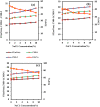The release of petroleum hydrocarbons from a saline-sodic soil by the new biosurfactant-producing strain of Bacillus sp
- PMID: 36396722
- PMCID: PMC9672099
- DOI: 10.1038/s41598-022-24321-3
The release of petroleum hydrocarbons from a saline-sodic soil by the new biosurfactant-producing strain of Bacillus sp
Abstract
Adsorption of old-aged petroleum hydrocarbons to the soil solid phase, which causes biosurfactant loss of performance, is among the limiting factors for the remediation of the saline-sodic soils contaminated with petroleum. Therefore, to find a functional biosurfactant in oil-contaminated saline-sodic soils, the efficiency of 39 bacteria isolated from petroleum-contaminated soils was evaluated. The strains were cultured in the Bushnell-Haas medium, and the produced biosurfactants and bioemulsifiers in this medium were extracted using chloroform/methanol and ethyl acetate extraction methods, respectively. Their partial purification was performed by column chromatography, and eventually, their performance in releasing TPH from the contaminated soil was evaluated. The soil test results revealed that the highest TPH releases due to the effects of the biosurfactants and bioemulsifier produced from SHA302, SH21, and SH72 isolates were 42.4% ± 0.2, 21.6% ± 0.15 and 24.3% ± 0.91, respectively. Based on the 16S rRNA gene sequence, the SHA302 strain showed 93.98% phylogenetic similarity with Bacillus pumilus strain ATCC 7061. The Fourier transform infrared spectroscopy and thin-layer chromatography results proved that the biosurfactants produced by isolates SHA302, SH21 and SH72 showed lipopeptide, glycolipoprotein and glycoprotein natures, respectively. The performance of the biosurfactant produced by SHA302 isolate indicated that it could be used as a good candidate for releasing TPH from saline-sodic soils with old contamination and facilitating the degradation of hydrocarbons.
© 2022. The Author(s).
Conflict of interest statement
The authors declare no competing interests.
Figures




Similar articles
-
Diversity of biosurfactant producing microorganisms isolated from soils contaminated with diesel oil.Microbiol Res. 2005;160(3):249-55. doi: 10.1016/j.micres.2004.08.005. Microbiol Res. 2005. PMID: 16035236
-
Production and characterization of surfactin-like biosurfactant produced by novel strain Bacillus nealsonii S2MT and it's potential for oil contaminated soil remediation.Microb Cell Fact. 2020 Jul 20;19(1):145. doi: 10.1186/s12934-020-01402-4. Microb Cell Fact. 2020. PMID: 32690027 Free PMC article.
-
Biosurfactant-producing strains in enhancing solubilization and biodegradation of petroleum hydrocarbons in groundwater.Environ Monit Assess. 2014 Jul;186(7):4581-9. doi: 10.1007/s10661-014-3721-x. Environ Monit Assess. 2014. PMID: 24659382
-
Electrokinetic-Enhanced Remediation of Phenanthrene-Contaminated Soil Combined with Sphingomonas sp. GY2B and Biosurfactant.Appl Biochem Biotechnol. 2016 Apr;178(7):1325-38. doi: 10.1007/s12010-015-1949-8. Epub 2015 Dec 18. Appl Biochem Biotechnol. 2016. PMID: 26683200 Review.
-
Mitigation of petroleum-hydrocarbon-contaminated hazardous soils using organic amendments: A review.J Hazard Mater. 2021 Aug 15;416:125702. doi: 10.1016/j.jhazmat.2021.125702. Epub 2021 Mar 22. J Hazard Mater. 2021. PMID: 33866291 Review.
Cited by
-
Novel Halotolerant Bacteria from Saline Environments: Isolation and Biomolecule Production.BioTech (Basel). 2025 Jun 19;14(2):49. doi: 10.3390/biotech14020049. BioTech (Basel). 2025. PMID: 40558398 Free PMC article.
References
-
- Ron EZ, Rosenberg E. Biosurfactants and oil bioremediation. Curr. Opin. Biotechnol. 2002;13(3):249–252. - PubMed
-
- Brassington KJ, et al. Weathered hydrocarbon wastes: A risk management primer. Crit. Rev. Environ. Sci. Technol. 2007;37(3):199–232.
-
- Hatzinger PB, Alexander M. Effect of aging of chemicals in soil on their biodegradability and extractability. Environ. Sci. Technol. 1995;29(2):537–545. - PubMed
-
- Schlebaum W, et al. Interactions between a hydrophobic organic chemical and natural organic matter: Equilibrium and kinetic studies. Environ. Sci. Technol. 1998;32(15):2273–2277.
Publication types
MeSH terms
Substances
LinkOut - more resources
Full Text Sources
Molecular Biology Databases

